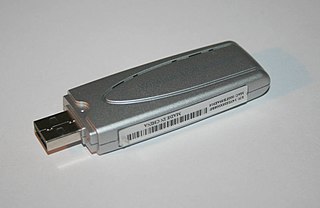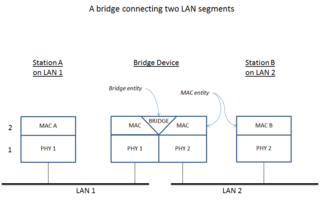IEEE 802.15 is a working group of the Institute of Electrical and Electronics Engineers (IEEE) IEEE 802 standards committee which specifies wireless personal area network (WPAN) standards. There are 10 major areas of development, not all of which are active.
IEEE 802 is a family of Institute of Electrical and Electronics Engineers (IEEE) standards for local area networks (LAN), personal area network (PAN), and metropolitan area networks (MAN). The IEEE 802 LAN/MAN Standards Committee (LMSC) maintains these standards. The IEEE 802 family of standards has twelve members, numbered 802.1 through 802.12, with a focus group of the LMSC devoted to each.

IEEE 802.11 is part of the IEEE 802 set of local area network (LAN) technical standards, and specifies the set of media access control (MAC) and physical layer (PHY) protocols for implementing wireless local area network (WLAN) computer communication. The standard and amendments provide the basis for wireless network products using the Wi-Fi brand and are the world's most widely used wireless computer networking standards. IEEE 802.11 is used in most home and office networks to allow laptops, printers, smartphones, and other devices to communicate with each other and access the Internet without connecting wires.
A media access control address is a unique identifier assigned to a network interface controller (NIC) for use as a network address in communications within a network segment. This use is common in most IEEE 802 networking technologies, including Ethernet, Wi-Fi, and Bluetooth. Within the Open Systems Interconnection (OSI) network model, MAC addresses are used in the medium access control protocol sublayer of the data link layer. As typically represented, MAC addresses are recognizable as six groups of two hexadecimal digits, separated by hyphens, colons, or without a separator.

Wi-Fi is a family of wireless network protocols, based on the IEEE 802.11 family of standards, which are commonly used for local area networking of devices and Internet access, allowing nearby digital devices to exchange data by radio waves. These are the most widely used computer networks in the world, used globally in home and small office networks to link desktop and laptop computers, tablet computers, smartphones, smart TVs, printers, and smart speakers together and to a wireless router to connect them to the Internet, and in wireless access points in public places like coffee shops, hotels, libraries and airports to provide the public Internet access for mobile devices.
The Spanning Tree Protocol (STP) is a network protocol that builds a loop-free logical topology for Ethernet networks. The basic function of STP is to prevent bridge loops and the broadcast radiation that results from them. Spanning tree also allows a network design to include backup links providing fault tolerance if an active link fails.
IEEE 802.15.4 is a technical standard which defines the operation of low-rate wireless personal area networks (LR-WPANs). It specifies the physical layer and media access control for LR-WPANs, and is maintained by the IEEE 802.15 working group, which defined the standard in 2003. It is the basis for the Zigbee, ISA100.11a, WirelessHART, MiWi, 6LoWPAN, Thread and SNAP specifications, each of which further extends the standard by developing the upper layers which are not defined in IEEE 802.15.4. In particular, 6LoWPAN defines a binding for the IPv6 version of the Internet Protocol (IP) over WPANs, and is itself used by upper layers like Thread.
IEEE 802.11i-2004, or 802.11i for short, is an amendment to the original IEEE 802.11, implemented as Wi-Fi Protected Access II (WPA2). The draft standard was ratified on 24 June 2004. This standard specifies security mechanisms for wireless networks, replacing the short Authentication and privacy clause of the original standard with a detailed Security clause. In the process, the amendment deprecated broken Wired Equivalent Privacy (WEP), while it was later incorporated into the published IEEE 802.11-2007 standard.
IEEE 802.22, is a standard for wireless regional area network (WRAN) using white spaces in the television (TV) frequency spectrum. The development of the IEEE 802.22 WRAN standard is aimed at using cognitive radio (CR) techniques to allow sharing of geographically unused spectrum allocated to the television broadcast service, on a non-interfering basis, to bring broadband access to hard-to-reach, low population density areas, typical of rural environments, and is therefore timely and has the potential for a wide applicability worldwide. It is the first worldwide effort to define a standardized air interface based on CR techniques for the opportunistic use of TV bands on a non-interfering basis.
IEEE 802.11r-2008 or fast BSS transition (FT), is an amendment to the IEEE 802.11 standard to permit continuous connectivity aboard wireless devices in motion, with fast and secure client transitions from one Basic Service Set to another performed in a nearly seamless manner. It was published on July 15, 2008. IEEE 802.11r-2008 was rolled up into 802.11-2012. The terms handoff and roaming are often used, although 802.11 transition is not a true handoff/roaming process in the cellular sense, where the process is coordinated by the base station and is generally uninterrupted.

A wireless network interface controller (WNIC) is a network interface controller which connects to a wireless network, such as Wi-Fi or Bluetooth, rather than a wired network, such as a Token Ring or Ethernet. A WNIC, just like other NICs, works on the layers 1 and 2 of the OSI model and uses an antenna to communicate via radio waves.

A network bridge is a computer networking device that creates a single, aggregate network from multiple communication networks or network segments. This function is called network bridging. Bridging is distinct from routing. Routing allows multiple networks to communicate independently and yet remain separate, whereas bridging connects two separate networks as if they were a single network. In the OSI model, bridging is performed in the data link layer. If one or more segments of the bridged network are wireless, the device is known as a wireless bridge.
802.11j-2004 or 802.11j is an amendment to the IEEE 802.11 standard designed specially for Japanese market. It allows Wireless LAN operation in the 4.9 to 5 GHz band to conform to the Japanese rules for radio operation for indoor, outdoor and mobile applications. The amendment has been incorporated into the published IEEE 802.11-2007 standard.
IEEE 802.1D is the Ethernet MAC bridges standard which includes bridging, Spanning Tree Protocol and others. It is standardized by the IEEE 802.1 working group. It includes details specific to linking many of the other 802 projects including the widely deployed 802.3 (Ethernet), 802.11 and 802.16 (WiMax) standards.
IEEE 802.11p is an approved amendment to the IEEE 802.11 standard to add wireless access in vehicular environments (WAVE), a vehicular communication system. It defines enhancements to 802.11 required to support Intelligent Transportation Systems (ITS) applications. This includes data exchange between high-speed vehicles and between the vehicles and the roadside infrastructure, so called V2X communication, in the licensed ITS band of 5.9 GHz (5.85–5.925 GHz). IEEE 1609 is a higher layer standard based on the IEEE 802.11p. It is also the basis of a European standard for vehicular communication known as ETSI ITS-G5.
IEEE 802.11n-2009 or 802.11n is a wireless-networking standard that uses multiple antennas to increase data rates. The Wi-Fi Alliance has also retroactively labelled the technology for the standard as Wi-Fi 4. It standardized support for multiple-input multiple-output, frame aggregation, and security improvements, among other features, and can be used in the 2.4 GHz or 5 GHz frequency bands.
IEEE P802.1p was a task group active from 1995 to 1998, responsible for adding traffic class expediting and dynamic multicast filtering to the IEEE 802.1D standard. The task group developed a mechanism for implementing quality of service (QoS) at the media access control (MAC) level. Although this technique is commonly referred to as IEEE 802.1p, the group's work with the new priority classes and Generic Attribute Registration Protocol (GARP) was not published separately but was incorporated into a major revision of the standard, IEEE 802.1D-1998, which subsequently was incorporated into IEEE 802.1Q-2014 standard. The work also required a short amendment extending the frame size of the Ethernet standard by four bytes which was published as IEEE 802.3ac in 1998.
IEEE 802.11ac-2013 or 802.11ac is a wireless networking standard in the IEEE 802.11 set of protocols, providing high-throughput wireless local area networks (WLANs) on the 5 GHz band. The standard has been retroactively labelled as Wi-Fi 5 by Wi-Fi Alliance.
IEEE 802.11k-2008 is an amendment to IEEE 802.11-2007 standard for radio resource measurement. It defines and exposes radio and network information to facilitate the management and maintenance of a mobile Wireless LAN. IEEE 802.11k was incorporated in IEEE Std 802.11-2012; see IEEE 802.11.
IEEE 802.11ay, Enhanced Throughput for Operation in License-exempt Bands above 45 GHz, is a follow-up to IEEE 802.11ad WiGig standard which quadruples the bandwidth and adds MIMO up to 8 streams. Development started in 2015 and the final standard IEEE 802.11ay-2021 was approved in March 2021.